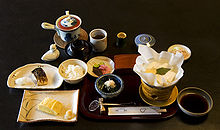Traditional Japanese cuisine
Breakfast at a ryokan (Japanese inn), featuring grilled mackerel, Kansai style dashimaki egg, tofu in kaminabe (paper pot)
Japanese cuisine is based on combining the staple food, which is steamed white rice or gohan (御飯), with one or several okazu or main dishes and side dishes. This may be accompanied by a clear or miso soup and tsukemono (pickles).
The phrase ichijū-sansai (一汁三菜, "one soup, three sides") refers to the makeup of a typical meal served, but has roots in classic kaiseki, honzen, and yūsoku cuisine. The term is also used to describe the first course served in standard kaiseki cuisine nowadays.
Rice is served in its own small bowl (chawan), and each course item is placed on its own small plate (sara) or bowl (hachi)
for each individual portion. This is done even at home. It contrasts
with the Western-style dinners at home, where each individual takes
helpings from the large serving dishes of food presented at the middle
of the dining table. Japanese style traditionally abhors different
flavored dishes touching each other on a single plate, so different
dishes are given their own individual plates as mentioned, or are
partitioned using leaves, etc. This is why in take-out sushi the tamagoyaki egg and fish, or blue-backed fish
and white-fleshed fish are carefully separated. Placing okazu on top of
rice and "soiling" it is also frowned upon by old-fashioned etiquette.
Though this tradition originated from Classical Chinese dining
formalities, especially after the adoption of Buddhism with its tea
ceremony, and became most popular and common during and after the Kamakura period, such as the Kaiseki.
Japanese cuisine keeps such tradition still, whereas in modern times
such practice is in sharp contrast to present day Chinese cuisine, where
placing food on rice is standard, However the exception is the popular donburi.
The small rice bowl or chawan
(lit. "tea bowl") doubles as a word for the large tea bowls in tea
ceremonies. Thus in common speech, the drinking cup is referred to as yunomi-jawan or yunomi for the purpose of distinction.
Kaiseki appetizers on a legged tray
In the olden days, among the nobility, each course of a full-course Japanese meal would be brought on serving napkins called zen (膳), which were originally platformed trays or small dining tables. In the modern age, faldstool trays or stackup-type legged trays may still be seen used in zashiki, i.e. tatami-mat rooms, for large banquets or at a ryokan type inn. Some restaurants might use the suffix -zen (膳) as a more sophisticated though dated synonym to the more familiar teishoku (定食), since the latter basically is a term for a combo meal served at a taishū-shokudō, akin to a diner. Teishoku means a meal of fixed menu, a dinner à prix fixe served at shokudō (食堂, "dining hall") or ryōriten (料理店, "restaurant"), which is somewhat vague (shokudō can mean a diner-type restaurant or a corporate lunch hall); but e.g. Ishikawa, Hiroyoshi (石川弘義) (1991). Taishū bunka jiten (snippet). Kōbundō. p. 516. defines it as fare served at teishoku-shokudō (定食食堂 "teishoku dining hall"), etc., a diner-like establishment.















0 comments:
Post a Comment